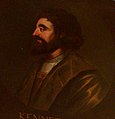English: A portrait of Kenneth III within a painted oval, in profile, facing the left, wearing an olive green coat over a gathered white skirt and a rust tabard. This portrait is one of ninety-three bust-lengths commissioned to decorate the Great Gallery at Holyroodhouse, Edinburgh. It is painted by Jacob de Wet II, a Dutch artist working in Scotland from 1673. Together with eighteen full-lengths these portraits illustrate the genealogy of the royal house of Scotland from Fergus I (who ascended the throne in 330 BC) to James VII (who abdicated in 1689). De Wet’s iconographic scheme was based on well-known chronicles of Scottish history by the Renaissance humanists Hector Boece (Scotorum Historiae, 1527) and George Buchanan (Rerum Scoticarum Historia, 1582). The inscriptions on the paintings correspond with Buchanan’s list of Scottish kings: from left to right, these are the number and name of the king followed by the date of accession. The dates however are considerably muddled, by a later restorer or perhaps even the artist himself. Both real and legendary, their purpose was to proclaim the authority of the Stuarts as divinely appointed rulers of Scotland. Commissioned and paid for by the Scottish Privy Council, the series was intended to convey the power and greatness of the country’s governing body as much as that of their king. With no authentic likenesses on which to base his portraits of medieval kings, de Wet made extensive use of an earlier set by the Scottish artist George Jamesone, of which twenty-six survive in private collections. From this limited basis the resulting series appears rather repetitious. Much more important than their aesthetic merit therefore was the symbolic power of painting an extremely long royal lineage stretching more than two millennia. Buchanan, Rerum Scoticarum Historia (translation from 1751): ‘Duffus’s Brother … A valiant and a wise Prince; but in the End became cruel, and slew Malcolm his Brother’s Son; and in God’s Judgement, who suffereth not innocent Blood to be unpunished, he was slain, as some say, by a Shaft or Arrow, shot by a Device or Sleight, out of an Image fixed in a Wall at Fettercairn, by the Means of a Noblewoman there, called Fenella’. Number 80 in the series. Inscribed KENNETHVS.3 970.
Provenance
Commissioned by the Scottish Privy Council in the name of Charles II.

